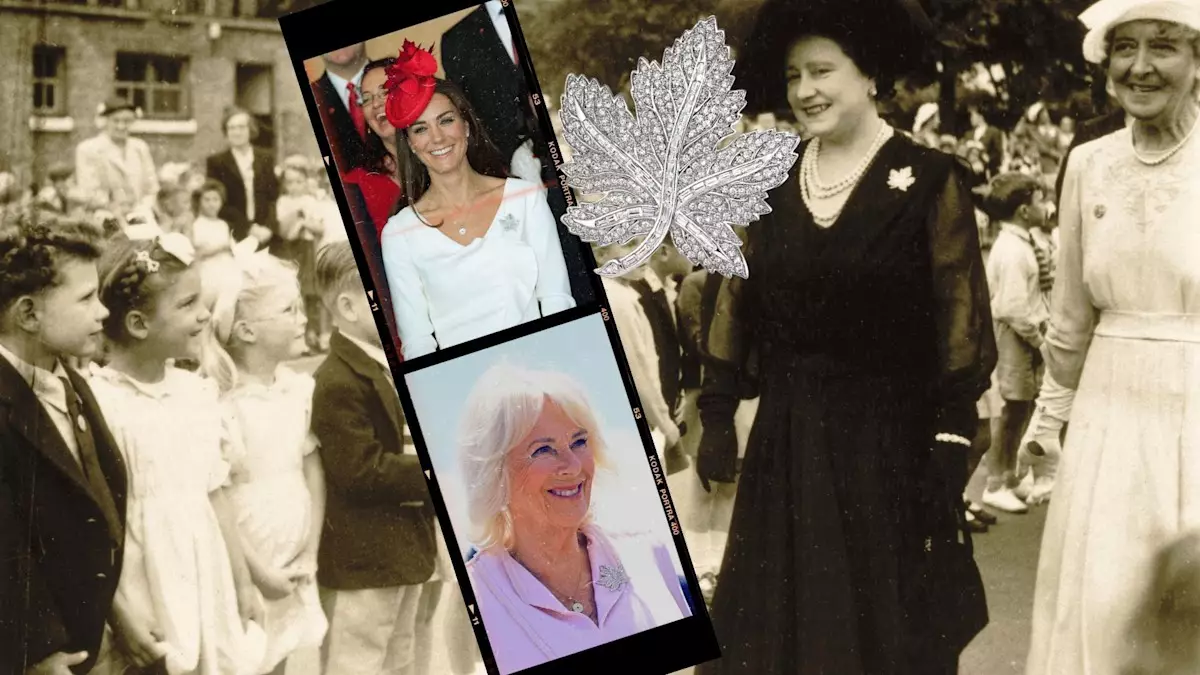Queen Camilla has demonstrated time and again that jewelry isn’t merely a fashion accessory; it serves as a means of storytelling, relaying history and sentiment in ways that words sometimes cannot. During her recent royal engagement in Canada, while her husband, King Charles, captivated audiences with a historic Speech from the Throne—an event unprecedented for a reigning monarch in nearly seven decades—it was the Queen’s jewelry choices that caught the eye of observers, illustrating how deeply intertwined fashion and royal diplomacy can be.
On the first day of her visit, Queen Camilla donned an elegant cream coat dress, complemented by nude suede heels and a dramatic wide-brim hat adorned with graceful feathers. Yet, it was the diamond maple leaf brooch she wore on her lapel that truly captured the essence of the occasion. This particular piece is not just ornamental; it is laden with significance, acting as a luminous emblem of both Canadian heritage and the royal family’s connection to it.
A Historical Legacy: The Maple Leaf Brooch
The diamond maple leaf brooch, designed in 1939 by the prestigious British jeweler Asprey, is crafted in platinum and adorned with exquisitely cut diamonds that emulate the striking shape of the sugar maple leaf—the national symbol of Canada. Originally bestowed upon Queen Elizabeth, the Queen Mother by King George VI during a momentous state visit to Canada, the brooch was not just a gift; it became an emblem of royal diplomacy and goodwill that resonated through generations.
Maxwell Stone, the creative director at UK jeweler Steven Stone, aptly highlighted the significance of the brooch, stating that it is “more than just a beautiful piece of jewelry”—it encapsulates the enduring friendship between the UK and Canada. This relationship, rich in history and mutual respect, finds a tangible representation in the diamond-studded brooch, which has now been worn by three generations of royal women, each bringing her unique touch and context to the piece.
Royal Connections: An Emotional Tribute
When Queen Elizabeth II inherited the brooch in 2002, she began integrating it into her wardrobe for key events, particularly Canada Day celebrations and important Commonwealth gatherings. In what could be interpreted as a gesture of trust and camaraderie, she also lent it to both Queen Camilla and the Princess of Wales for their tours of Canada, transforming the brooch into one of the most cherished and shared pieces in the royal jewelry collection. This act reinforces the idea that jewelry, in royal contexts, acts as a bridge—linking generations and solidifying ties within the family as well as with nations.
Moreover, it reflects the tradition of royal women selecting attire and accessories that hold greater significance, transcending mere aesthetics. By choosing to wear the maple leaf brooch during her visit, Queen Camilla not only paid homage to her royal predecessors but also made a heartfelt nod to the people of Canada.
Symbolism Beyond the Surface
Camilla’s choice of the diamond maple leaf brooch was clearly intentional, reverberating with a strong diplomatic tone. In a world where the royal family’s role continues to be scrutinized, each public appearance is a reminder of their responsibility towards maintaining relationships, and the symbols they choose to wear carry immense weight. The brooch stands as a poignant reminder of the past while simultaneously crafting narratives for the present and future.
Additionally, the Queen’s selection of jewelry often underscores significant themes. On this occasion, the combination of the maple leaf brooch with her other accessories, including the inspired Asprey 167 Button Pendant—a piece that symbolizes elegance with its amethyst centerpiece and diamond pavé—creates a visual narrative steeped in royal heritage and contemporary style.
Queen Camilla’s sartorial choices resonate far beyond style. They serve as a bridge between tradition and modernity, symbolizing respect toward a nation while simultaneously fostering royal connections that continue to evolve. Her fashion decisions may be scrutinized for their aesthetic appeal, but they represent significant cultural dialogues, intertwining royal lineage with national identity, ensuring that the legacy of royal fashion remains as captivating as the crowns themselves.


Leave a Reply